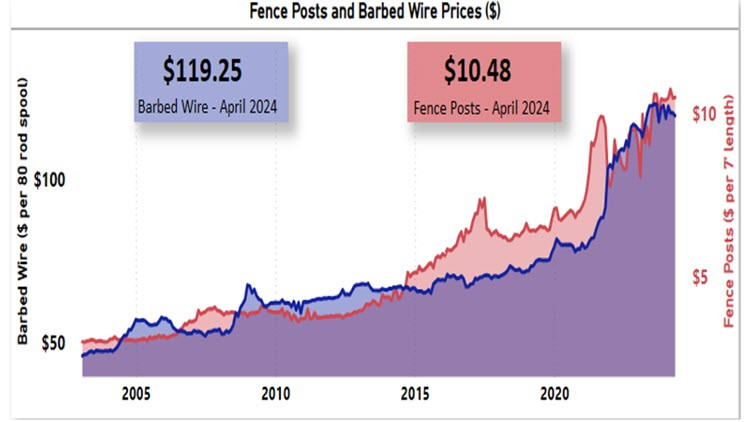Source: Government of Alberta
“Effective grazing management relies on fencing to keep livestock out of neighbouring pastures and off major highways,” says Azam Nikzad, market analyst/coordinating researcher with the Alberta government. “Well-designed fences not only enhance animal comfort and productivity but also contribute to labour efficiency. Various types of fencing—such as electric, high-tensile, woven, and barbed wire—exist, each chosen based on factors like livestock species, installation cost, material availability and maintenance considerations.”
The impact of barbed wire on agriculture extends beyond cost-effective fencing. It had a significant impact on agricultural development by protecting land and enabling farmers to use the land for specific purposes. Moreover, barbed wire fencing enhances cattle productivity through improved feeding and breeding practices. It allows the production of cattle and crops in proximity.
Invented in 1874, barbed wire possesses 3 crucial characteristics: it prevents cattle from breaking through the fence, its twisted wires tolerate temperature fluctuations, and it is easy to manufacture. Beyond these attributes, barbed wire offers several advantages: it is cost-effective, requires minimal labour, boasts durability and remains low maintenance when properly installed. However, regular inspections are crucial for safety.
“Fencing is a major expense in cattle grazing,” explains Nikzad. “Over the past decade, the price of barbed wire and fence posts has shown a consistent upward trend. The rate of increase has accelerated in the last 5 years, with an average annual increase over 11% for both inputs.”
The year 2021 marked the peak of this trend for barbed wire with the highest annual increase over 32%. For fence posts the peak was in 2023 with a 29% annual increase. In April 2024, the prices decreased for barbed wire by over 2% compared to January 2024, while there was a slight increase in prices for fence posts.
Figure 1. Fence posts and barbed wire prices ($)

Barbed wire specs: standard 12-gauge double strand barbed wire; for use in livestock fencing. Manufactured in Canada. Price per 80 rod spool weighing 40 kg. Fence post specs: standard grade fence posts, treated, 3-4″ diameter, 7′ lengths; for use in barbed wire fencing. Price per one 7′ post.
In 2023, Alberta imported more than 337 tons of barbed wire, showing a significant increase of over 173% compared to 2022. China and Mexico are the main suppliers of barbed wire imports to Alberta.
During 2022-23, the estimated cost to install a 4-strand barbed wire fence in Saskatchewan was $7,391.80/mile, covering material, equipment and labour expenses. Manitoba’s Beef Cow-Calf Production Cost for 2023 showed a similar cost of $7,444/mile. Of this total, 65% accounts for materials, 20% for equipment, and 15% for labour. Additionally, annual maintenance costs are approximately 2% of the initial investment, totaling $149/mile.
“Factors affecting fencing costs include barbed wire coating, numbers of strands, wire thickness, tensile strength, numbers of barbs, fence post types, terrain, slope and land shape. Barbed wire, primarily made of steel, is sensitive to steel price fluctuations. High demand for steel drives up steel prices, directly affecting barbed wire prices,” explains Nikzad.
For the first time in a long while, the cattle industry shows promise of expansion due to record-high prices and improved profitability. It is important to mention the loss of pastureland over the past 2 decades. According to the 2021 Census of Agriculture, there was a 5% decline in tame or seeded pasture compared to 2001, along with a 7% increase in croplands.
“Less pastureland suggests less need for fencing, and some fences around land previously in pasture may have fallen into disrepair. The state of the fences can be a critical factor influencing a producer’s decisions on cow herd expansion or even entry into the business. Barbed wire fences remain essential infrastructure on Alberta’s farms and ranches,” says Nikzad.









